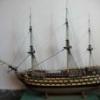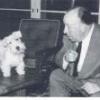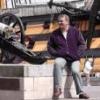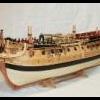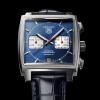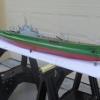Supplies of the Ship Modeler's Handbook are running out. Get your copy NOW before they are gone! Click on photo to order.
×
-
Posts
4,873 -
Joined
-
Last visited
Reputation Activity
-
 gjdale got a reaction from popeye the sailor in BLUENOSE By Jerry - Model Shipways - Scale 1:64
gjdale got a reaction from popeye the sailor in BLUENOSE By Jerry - Model Shipways - Scale 1:64
....along with a grand piano......so who plays Jerry? You or Charlene, or both of you? And what type of music gets played?
-
 gjdale got a reaction from Martin W in Granado by rafine - FINISHED - Caldercraft - 1:64
gjdale got a reaction from Martin W in Granado by rafine - FINISHED - Caldercraft - 1:64
They look pretty good from this distance Bob!
-
 gjdale got a reaction from FriedClams in SS Kaiser Wilhelm der Grosse 1897 by Mirabell61 - FINISHED - scale 1:144 - POF - first German four stacker of the Norddeutscher Lloyd line
gjdale got a reaction from FriedClams in SS Kaiser Wilhelm der Grosse 1897 by Mirabell61 - FINISHED - scale 1:144 - POF - first German four stacker of the Norddeutscher Lloyd line
Just stunning Nils! What a lovely model you are producing here. Every update shows your care and attention to detail.
-
 gjdale got a reaction from hamilton in 1949 Chris-Craft 19' Racing Runabout by gjdale - FINISHED -Dumas - 1:8 Scale - RADIO
gjdale got a reaction from hamilton in 1949 Chris-Craft 19' Racing Runabout by gjdale - FINISHED -Dumas - 1:8 Scale - RADIO
Thanks Keith, Mobbsie, Ken, Sam and Popeye for your generous comments, and to all those who hit the "like" button.
Wheel Building Continued
The spoke holders, which will be attached to the inner face of the wheel rim, were next to be machined. These are milled from a piece of brass stock 1/4” wide by 1/16” thick. The outer end of each piece needs to be milled with a convex radius of 1” (to mate with the 2” diameter of the wheel). Additionally, the end needs to be cut with a concave surface so that it will mate cleanly with the curved surface of the wheel rim.
Kip gave a good description of his process, using the rotary table to achieve the convex radius and a 3mm ball-end cutter to achieve the concave cut. While it took me a while to get my head around all of this, eventually it made sense. However, I came unstuck in trying to follow Kip’s method exactly as he used a narrow vice to hold the parts while milling the 1” radius.
Without a thinner vice, I had to devise a holding jig of some sort. It took several days of thinking through but I got there in the end…… I started by drilling a series of 9/16" clearance holes in the 1/4" x 1/16" brass strip, starting 10mm from the end and then at 15mm spacing between centres. I then drilled and tapped two 6-32 holes in a piece of scrap timber such that one was centred 5mm from the end and the other 20mm from the end. This meant that when I attached the brass strip to the timber, it would be held securely with 5mm overhanging the end of the timber while the rear most cap screw would be centred 25mm from the end of the brass. Then I just needed to align that cap screw in the centre of the vice, over the centre of the rotary table and then offset that centre from the cutting bit by 25mm (+ 1.5mm for the radius of cutter). Here is a picture of the overall setup.
And a close-up of the holding jig:
After making the first pass to create the end shape, I removed the strip from the jig and cut off the end at a pre-marked point using a razor saw and mitre box. Because of the threaded hold-downs, I was able to remove and replace the strip in the holding jig without changing any settings on the X,Y or Z axes of the mill by simply undoing the 6-32 cap screws. After cutting off the freshly milled piece, I simply re-installed it with the next set of holes to have the end protruding exactly the right amount again and we were ready to repeat the milling cut.
Here is another close-up of the milling in process:
And here are the five resulting pieces ready to be cut to final length. I only need three of these but thought it best to make a couple of spares. Turned out to be a good decision!
The next step was to cut these to final length. According to Kip’s instructions, that length was to be 7/64”. I converted that to metric to make it easier to operate the mill wheels, and rounded up slightly to 3.0 mm. In order to cut these precisely to the same length, I made a jig to hold them in the mill vice while I used the slitting saw to make the cut. The parts were held onto the jig temporarily with CA glue. Here is the setup:
It turns out that CA is not a good choice to use for this purpose. When it heats up the bond gives way fairly easily. I’ll put that one in my Homer Simpson “Doh!” file!!! So, those extra two parts came in quite handy as by the time I’d completed the cut, two of the “keeper” ends had vanished (although I had all five of the “offcut” ends!).
Here’s a pic of the final parts cut to size. The tweezers in the background are to give a sense of scale.
And just in case that doesn’t do it for you, here is a shot with all three of the pieces on the fingernail of my index finger.
Man, these things are small! And the next job will be to drill a series of 0.5 mm holes into the long narrow inboard edge to receive the spokes. Stay tuned….
-
 gjdale got a reaction from GuntherMT in 1949 Chris-Craft 19' Racing Runabout by gjdale - FINISHED -Dumas - 1:8 Scale - RADIO
gjdale got a reaction from GuntherMT in 1949 Chris-Craft 19' Racing Runabout by gjdale - FINISHED -Dumas - 1:8 Scale - RADIO
Thanks Keith, Mobbsie, Ken, Sam and Popeye for your generous comments, and to all those who hit the "like" button.
Wheel Building Continued
The spoke holders, which will be attached to the inner face of the wheel rim, were next to be machined. These are milled from a piece of brass stock 1/4” wide by 1/16” thick. The outer end of each piece needs to be milled with a convex radius of 1” (to mate with the 2” diameter of the wheel). Additionally, the end needs to be cut with a concave surface so that it will mate cleanly with the curved surface of the wheel rim.
Kip gave a good description of his process, using the rotary table to achieve the convex radius and a 3mm ball-end cutter to achieve the concave cut. While it took me a while to get my head around all of this, eventually it made sense. However, I came unstuck in trying to follow Kip’s method exactly as he used a narrow vice to hold the parts while milling the 1” radius.
Without a thinner vice, I had to devise a holding jig of some sort. It took several days of thinking through but I got there in the end…… I started by drilling a series of 9/16" clearance holes in the 1/4" x 1/16" brass strip, starting 10mm from the end and then at 15mm spacing between centres. I then drilled and tapped two 6-32 holes in a piece of scrap timber such that one was centred 5mm from the end and the other 20mm from the end. This meant that when I attached the brass strip to the timber, it would be held securely with 5mm overhanging the end of the timber while the rear most cap screw would be centred 25mm from the end of the brass. Then I just needed to align that cap screw in the centre of the vice, over the centre of the rotary table and then offset that centre from the cutting bit by 25mm (+ 1.5mm for the radius of cutter). Here is a picture of the overall setup.
And a close-up of the holding jig:
After making the first pass to create the end shape, I removed the strip from the jig and cut off the end at a pre-marked point using a razor saw and mitre box. Because of the threaded hold-downs, I was able to remove and replace the strip in the holding jig without changing any settings on the X,Y or Z axes of the mill by simply undoing the 6-32 cap screws. After cutting off the freshly milled piece, I simply re-installed it with the next set of holes to have the end protruding exactly the right amount again and we were ready to repeat the milling cut.
Here is another close-up of the milling in process:
And here are the five resulting pieces ready to be cut to final length. I only need three of these but thought it best to make a couple of spares. Turned out to be a good decision!
The next step was to cut these to final length. According to Kip’s instructions, that length was to be 7/64”. I converted that to metric to make it easier to operate the mill wheels, and rounded up slightly to 3.0 mm. In order to cut these precisely to the same length, I made a jig to hold them in the mill vice while I used the slitting saw to make the cut. The parts were held onto the jig temporarily with CA glue. Here is the setup:
It turns out that CA is not a good choice to use for this purpose. When it heats up the bond gives way fairly easily. I’ll put that one in my Homer Simpson “Doh!” file!!! So, those extra two parts came in quite handy as by the time I’d completed the cut, two of the “keeper” ends had vanished (although I had all five of the “offcut” ends!).
Here’s a pic of the final parts cut to size. The tweezers in the background are to give a sense of scale.
And just in case that doesn’t do it for you, here is a shot with all three of the pieces on the fingernail of my index finger.
Man, these things are small! And the next job will be to drill a series of 0.5 mm holes into the long narrow inboard edge to receive the spokes. Stay tuned….
-
 gjdale reacted to Captain Slog in 1949 Chris-Craft 19' Racing Runabout by gjdale - FINISHED -Dumas - 1:8 Scale - RADIO
gjdale reacted to Captain Slog in 1949 Chris-Craft 19' Racing Runabout by gjdale - FINISHED -Dumas - 1:8 Scale - RADIO
Great stuff Grant, you are certainly well set up for creating these parts. Look forward to seeing the finished article.
Cheers
Slog
-
 gjdale got a reaction from mobbsie in 1949 Chris-Craft 19' Racing Runabout by gjdale - FINISHED -Dumas - 1:8 Scale - RADIO
gjdale got a reaction from mobbsie in 1949 Chris-Craft 19' Racing Runabout by gjdale - FINISHED -Dumas - 1:8 Scale - RADIO
Thanks Keith, Mobbsie, Ken, Sam and Popeye for your generous comments, and to all those who hit the "like" button.
Wheel Building Continued
The spoke holders, which will be attached to the inner face of the wheel rim, were next to be machined. These are milled from a piece of brass stock 1/4” wide by 1/16” thick. The outer end of each piece needs to be milled with a convex radius of 1” (to mate with the 2” diameter of the wheel). Additionally, the end needs to be cut with a concave surface so that it will mate cleanly with the curved surface of the wheel rim.
Kip gave a good description of his process, using the rotary table to achieve the convex radius and a 3mm ball-end cutter to achieve the concave cut. While it took me a while to get my head around all of this, eventually it made sense. However, I came unstuck in trying to follow Kip’s method exactly as he used a narrow vice to hold the parts while milling the 1” radius.
Without a thinner vice, I had to devise a holding jig of some sort. It took several days of thinking through but I got there in the end…… I started by drilling a series of 9/16" clearance holes in the 1/4" x 1/16" brass strip, starting 10mm from the end and then at 15mm spacing between centres. I then drilled and tapped two 6-32 holes in a piece of scrap timber such that one was centred 5mm from the end and the other 20mm from the end. This meant that when I attached the brass strip to the timber, it would be held securely with 5mm overhanging the end of the timber while the rear most cap screw would be centred 25mm from the end of the brass. Then I just needed to align that cap screw in the centre of the vice, over the centre of the rotary table and then offset that centre from the cutting bit by 25mm (+ 1.5mm for the radius of cutter). Here is a picture of the overall setup.
And a close-up of the holding jig:
After making the first pass to create the end shape, I removed the strip from the jig and cut off the end at a pre-marked point using a razor saw and mitre box. Because of the threaded hold-downs, I was able to remove and replace the strip in the holding jig without changing any settings on the X,Y or Z axes of the mill by simply undoing the 6-32 cap screws. After cutting off the freshly milled piece, I simply re-installed it with the next set of holes to have the end protruding exactly the right amount again and we were ready to repeat the milling cut.
Here is another close-up of the milling in process:
And here are the five resulting pieces ready to be cut to final length. I only need three of these but thought it best to make a couple of spares. Turned out to be a good decision!
The next step was to cut these to final length. According to Kip’s instructions, that length was to be 7/64”. I converted that to metric to make it easier to operate the mill wheels, and rounded up slightly to 3.0 mm. In order to cut these precisely to the same length, I made a jig to hold them in the mill vice while I used the slitting saw to make the cut. The parts were held onto the jig temporarily with CA glue. Here is the setup:
It turns out that CA is not a good choice to use for this purpose. When it heats up the bond gives way fairly easily. I’ll put that one in my Homer Simpson “Doh!” file!!! So, those extra two parts came in quite handy as by the time I’d completed the cut, two of the “keeper” ends had vanished (although I had all five of the “offcut” ends!).
Here’s a pic of the final parts cut to size. The tweezers in the background are to give a sense of scale.
And just in case that doesn’t do it for you, here is a shot with all three of the pieces on the fingernail of my index finger.
Man, these things are small! And the next job will be to drill a series of 0.5 mm holes into the long narrow inboard edge to receive the spokes. Stay tuned….
-
 gjdale got a reaction from hexnut in 1949 Chris-Craft 19' Racing Runabout by gjdale - FINISHED -Dumas - 1:8 Scale - RADIO
gjdale got a reaction from hexnut in 1949 Chris-Craft 19' Racing Runabout by gjdale - FINISHED -Dumas - 1:8 Scale - RADIO
Thanks Keith, Mobbsie, Ken, Sam and Popeye for your generous comments, and to all those who hit the "like" button.
Wheel Building Continued
The spoke holders, which will be attached to the inner face of the wheel rim, were next to be machined. These are milled from a piece of brass stock 1/4” wide by 1/16” thick. The outer end of each piece needs to be milled with a convex radius of 1” (to mate with the 2” diameter of the wheel). Additionally, the end needs to be cut with a concave surface so that it will mate cleanly with the curved surface of the wheel rim.
Kip gave a good description of his process, using the rotary table to achieve the convex radius and a 3mm ball-end cutter to achieve the concave cut. While it took me a while to get my head around all of this, eventually it made sense. However, I came unstuck in trying to follow Kip’s method exactly as he used a narrow vice to hold the parts while milling the 1” radius.
Without a thinner vice, I had to devise a holding jig of some sort. It took several days of thinking through but I got there in the end…… I started by drilling a series of 9/16" clearance holes in the 1/4" x 1/16" brass strip, starting 10mm from the end and then at 15mm spacing between centres. I then drilled and tapped two 6-32 holes in a piece of scrap timber such that one was centred 5mm from the end and the other 20mm from the end. This meant that when I attached the brass strip to the timber, it would be held securely with 5mm overhanging the end of the timber while the rear most cap screw would be centred 25mm from the end of the brass. Then I just needed to align that cap screw in the centre of the vice, over the centre of the rotary table and then offset that centre from the cutting bit by 25mm (+ 1.5mm for the radius of cutter). Here is a picture of the overall setup.
And a close-up of the holding jig:
After making the first pass to create the end shape, I removed the strip from the jig and cut off the end at a pre-marked point using a razor saw and mitre box. Because of the threaded hold-downs, I was able to remove and replace the strip in the holding jig without changing any settings on the X,Y or Z axes of the mill by simply undoing the 6-32 cap screws. After cutting off the freshly milled piece, I simply re-installed it with the next set of holes to have the end protruding exactly the right amount again and we were ready to repeat the milling cut.
Here is another close-up of the milling in process:
And here are the five resulting pieces ready to be cut to final length. I only need three of these but thought it best to make a couple of spares. Turned out to be a good decision!
The next step was to cut these to final length. According to Kip’s instructions, that length was to be 7/64”. I converted that to metric to make it easier to operate the mill wheels, and rounded up slightly to 3.0 mm. In order to cut these precisely to the same length, I made a jig to hold them in the mill vice while I used the slitting saw to make the cut. The parts were held onto the jig temporarily with CA glue. Here is the setup:
It turns out that CA is not a good choice to use for this purpose. When it heats up the bond gives way fairly easily. I’ll put that one in my Homer Simpson “Doh!” file!!! So, those extra two parts came in quite handy as by the time I’d completed the cut, two of the “keeper” ends had vanished (although I had all five of the “offcut” ends!).
Here’s a pic of the final parts cut to size. The tweezers in the background are to give a sense of scale.
And just in case that doesn’t do it for you, here is a shot with all three of the pieces on the fingernail of my index finger.
Man, these things are small! And the next job will be to drill a series of 0.5 mm holes into the long narrow inboard edge to receive the spokes. Stay tuned….
-
 gjdale got a reaction from Rustyj in 1949 Chris-Craft 19' Racing Runabout by gjdale - FINISHED -Dumas - 1:8 Scale - RADIO
gjdale got a reaction from Rustyj in 1949 Chris-Craft 19' Racing Runabout by gjdale - FINISHED -Dumas - 1:8 Scale - RADIO
Thanks Keith, Mobbsie, Ken, Sam and Popeye for your generous comments, and to all those who hit the "like" button.
Wheel Building Continued
The spoke holders, which will be attached to the inner face of the wheel rim, were next to be machined. These are milled from a piece of brass stock 1/4” wide by 1/16” thick. The outer end of each piece needs to be milled with a convex radius of 1” (to mate with the 2” diameter of the wheel). Additionally, the end needs to be cut with a concave surface so that it will mate cleanly with the curved surface of the wheel rim.
Kip gave a good description of his process, using the rotary table to achieve the convex radius and a 3mm ball-end cutter to achieve the concave cut. While it took me a while to get my head around all of this, eventually it made sense. However, I came unstuck in trying to follow Kip’s method exactly as he used a narrow vice to hold the parts while milling the 1” radius.
Without a thinner vice, I had to devise a holding jig of some sort. It took several days of thinking through but I got there in the end…… I started by drilling a series of 9/16" clearance holes in the 1/4" x 1/16" brass strip, starting 10mm from the end and then at 15mm spacing between centres. I then drilled and tapped two 6-32 holes in a piece of scrap timber such that one was centred 5mm from the end and the other 20mm from the end. This meant that when I attached the brass strip to the timber, it would be held securely with 5mm overhanging the end of the timber while the rear most cap screw would be centred 25mm from the end of the brass. Then I just needed to align that cap screw in the centre of the vice, over the centre of the rotary table and then offset that centre from the cutting bit by 25mm (+ 1.5mm for the radius of cutter). Here is a picture of the overall setup.
And a close-up of the holding jig:
After making the first pass to create the end shape, I removed the strip from the jig and cut off the end at a pre-marked point using a razor saw and mitre box. Because of the threaded hold-downs, I was able to remove and replace the strip in the holding jig without changing any settings on the X,Y or Z axes of the mill by simply undoing the 6-32 cap screws. After cutting off the freshly milled piece, I simply re-installed it with the next set of holes to have the end protruding exactly the right amount again and we were ready to repeat the milling cut.
Here is another close-up of the milling in process:
And here are the five resulting pieces ready to be cut to final length. I only need three of these but thought it best to make a couple of spares. Turned out to be a good decision!
The next step was to cut these to final length. According to Kip’s instructions, that length was to be 7/64”. I converted that to metric to make it easier to operate the mill wheels, and rounded up slightly to 3.0 mm. In order to cut these precisely to the same length, I made a jig to hold them in the mill vice while I used the slitting saw to make the cut. The parts were held onto the jig temporarily with CA glue. Here is the setup:
It turns out that CA is not a good choice to use for this purpose. When it heats up the bond gives way fairly easily. I’ll put that one in my Homer Simpson “Doh!” file!!! So, those extra two parts came in quite handy as by the time I’d completed the cut, two of the “keeper” ends had vanished (although I had all five of the “offcut” ends!).
Here’s a pic of the final parts cut to size. The tweezers in the background are to give a sense of scale.
And just in case that doesn’t do it for you, here is a shot with all three of the pieces on the fingernail of my index finger.
Man, these things are small! And the next job will be to drill a series of 0.5 mm holes into the long narrow inboard edge to receive the spokes. Stay tuned….
-
 gjdale got a reaction from CaptainSteve in Licorne 1755 by mtaylor - 3/16" scale - French Frigate - from Hahn plans - Version 2.0 - TERMINATED
gjdale got a reaction from CaptainSteve in Licorne 1755 by mtaylor - 3/16" scale - French Frigate - from Hahn plans - Version 2.0 - TERMINATED
Nice work on the cradle Mark. Can't wait to see her free of the building jig.
-
 gjdale got a reaction from src in Borodino by Captain Slog - Dom Bumagi - 1:200 - CARD
gjdale got a reaction from src in Borodino by Captain Slog - Dom Bumagi - 1:200 - CARD
Looks great Slog. Had you considered soldering the handrail pieces together before applying to the skylights? Was just thinking you could do this, leave the "legs" a bit longer and then trim them to length prior to fitting. Might save some aggro with trying to glue them together?
-
 gjdale reacted to Trussben in HMS Pegasus 1776 by Trussben - 1:48 - Swan-class sloop based on TFFM
gjdale reacted to Trussben in HMS Pegasus 1776 by Trussben - 1:48 - Swan-class sloop based on TFFM
Old forward section has been installed and reinforced with copper wire and epoxy the same as the aft section.
Ben
-
 gjdale reacted to Trussben in HMS Pegasus 1776 by Trussben - 1:48 - Swan-class sloop based on TFFM
gjdale reacted to Trussben in HMS Pegasus 1776 by Trussben - 1:48 - Swan-class sloop based on TFFM
Thanks for all the likes.
Old stern section has been installed, and reinforced with 18ga copper wire epoxied through into the keel.
Next up will be installing the old stem section in the same fashion.
Ben
-
 gjdale got a reaction from grsjax in bandsaw questions
gjdale got a reaction from grsjax in bandsaw questions
If you want to learn how to set up your bandsaw properly, take a look at this you tube clip of Alex Snodgrass:
I watched this, took notes, then went and applied it to my bandsaw (I'm a complete bandsaw neophyte too), and it worked a treat. Very simple and easy to follow.
As for ripping planks - I would think you would need a re-saw blade for this. From what I've read, this is what the serious woodworkers use for cutting veneers on the bandsaw.
That said, I agree with other advice that a table saw is a better choice for this task.
-
 gjdale got a reaction from CaptainSteve in Borodino by Captain Slog - Dom Bumagi - 1:200 - CARD
gjdale got a reaction from CaptainSteve in Borodino by Captain Slog - Dom Bumagi - 1:200 - CARD
Looks great Slog. Had you considered soldering the handrail pieces together before applying to the skylights? Was just thinking you could do this, leave the "legs" a bit longer and then trim them to length prior to fitting. Might save some aggro with trying to glue them together?
-
 gjdale got a reaction from mtaylor in Borodino by Captain Slog - Dom Bumagi - 1:200 - CARD
gjdale got a reaction from mtaylor in Borodino by Captain Slog - Dom Bumagi - 1:200 - CARD
Looks great Slog. Had you considered soldering the handrail pieces together before applying to the skylights? Was just thinking you could do this, leave the "legs" a bit longer and then trim them to length prior to fitting. Might save some aggro with trying to glue them together?
-
 gjdale got a reaction from Elijah in Phantom by Elijah - FINISHED - Model Shipways - 1:96 - New York Pilot Boat
gjdale got a reaction from Elijah in Phantom by Elijah - FINISHED - Model Shipways - 1:96 - New York Pilot Boat
Well done Elijah - almost there!
-
 gjdale got a reaction from Captain Slog in Borodino by Captain Slog - Dom Bumagi - 1:200 - CARD
gjdale got a reaction from Captain Slog in Borodino by Captain Slog - Dom Bumagi - 1:200 - CARD
Looks great Slog. Had you considered soldering the handrail pieces together before applying to the skylights? Was just thinking you could do this, leave the "legs" a bit longer and then trim them to length prior to fitting. Might save some aggro with trying to glue them together?
-
 gjdale got a reaction from CDW in Borodino by Captain Slog - Dom Bumagi - 1:200 - CARD
gjdale got a reaction from CDW in Borodino by Captain Slog - Dom Bumagi - 1:200 - CARD
Looks great Slog. Had you considered soldering the handrail pieces together before applying to the skylights? Was just thinking you could do this, leave the "legs" a bit longer and then trim them to length prior to fitting. Might save some aggro with trying to glue them together?
-
 gjdale got a reaction from Canute in Phantom by Elijah - FINISHED - Model Shipways - 1:96 - New York Pilot Boat
gjdale got a reaction from Canute in Phantom by Elijah - FINISHED - Model Shipways - 1:96 - New York Pilot Boat
Well done Elijah - almost there!
-
 gjdale reacted to Mike Y in Byrnes Drawplate
gjdale reacted to Mike Y in Byrnes Drawplate
Yes, I draw a boxwood nails. Requires a nice straight grained piece to cut the strips from, but works fine after some practice. Also works as a reliable mood measurement tool. One must be totally calm when using it - otherwise the piece will snap somewhere in the small hole
-
 gjdale reacted to archjofo in La Créole 1827 by archjofo - Scale 1/48 - French corvette
gjdale reacted to archjofo in La Créole 1827 by archjofo - Scale 1/48 - French corvette
Today I show bending aids for the production of chainplates.
A complete chainplate I have made in advance to see
how it works.
Since the deadeyes have different diameters, the chainplates are also made with different
wire thicknesses, namely 0.7 mm, 0.6 mm and 0.4 mm brass wire.
-
 gjdale reacted to Captain Slog in Borodino by Captain Slog - Dom Bumagi - 1:200 - CARD
gjdale reacted to Captain Slog in Borodino by Captain Slog - Dom Bumagi - 1:200 - CARD
Thanks to everyone for the likes.
Hi Nick, I am glad you are getting some ideas from my log. I have just started using the Roket glue myself so experience is a bit limited but really liking it so far. Thanks for the heads up on the Glue n’ Glaze. I have watched some YouTube videos and it looks like it would fit the bill for the bridge windows when I get there. I see the place I got the Roket glue also stock it so will keep it in mind when I get to that stage.
Hi DR, thanks for your comment. I would say it’s more like I am getting to get grips with card modelling! One of the challenges I have found with card modelling is just how much thought needs to go into putting them together, what with incorrectly shaped parts (as the example above) and dealing with diagrams which only show the completed assembly. They usually don’t show you how they got there.
The last parts of this structure are some skylights which run down each side. The top left strip shows 3 porthole options; the printed portholes (which I do like), middle skylight is the 1.6mm GPM portholes which are slightly too big and the right hand sky light shows the small portholes from the Borodino detail set which I forgot about.
The detail set ones were a better size for fitting in the limited space but I don’t like working with these. They are so much thinner than the 1.6mm GPM ones and difficult to handle. The bottom strip shows all the skylights punched out and the portholes inserted with mylar glazing. The mylar had to be trimmed very close to the portholes so it didn’t go past the hatches. The port-holing (?) was done prior to cutting out as the parts are pretty small and to prevent the punching operation distorting the sides.
The complete skylights are pretty simple only having 4 parts; the body and 3 hatches. The fold lines were carried through to the backside and scored ready for folding. The 2 ends were folded inwards and the top down and then glued up. Here the glued up body is sitting on the end on a square so I could press the hatch down flat for gluing. The hatches were cut out using the same method as the doors in the previous post. I glued in the middle hatch first then the 2 outer ones so I didn’t run off the end of one side.
The finished skylights glued into position and that completes Assembly 15.
Final thoughts? Well firstly this is the kind of structures/components/assemblies I love doing. I reckon it turned out not to bad and pretty chuffed with it. It’s a pity about the forms being wrong but this type of thing crops up with card modelling and it wasn’t a show stopper, just annoying.
Certainly I could have done better. The main thing that springs to mind is some of the areas where the top and side skins butt against each other aren’t perfect; the side skin popped up proud or dipped down below the top at some areas.
You may have noticed a couple of white squares on the top of the structure, well this is for a couple of additional skylights (Part 19) so I thought I may as well do these now to add a bit more detail to the structure.
There are a total of 3 No.19 skylights; 2 for the completed structure above and another one for a different part of the build but I decided to do all 3 rather than come back to do one later. Again not much parts to these; a base, a top and 4 little hatches with portholes.
The diagram also shows that I need to add hand rails b2 and b3 round the perimeter of the skylight and these will need to be made up with 0.2mm brass wire.
The steps shown to make the basic skylight. I did pin prick the handrail holes before cutting anything out for ease of access. The bases were cut and folded at the bend lines as normal and the ends glued together. The last step shows the top with the hatches installed as one unit. I did also try placing the top first and then attaching the hatches. Both methods have pros and cons but either or is fine.
The space for portholes on the little hatches is starting to get tight for space!
Two of the three completed skylights shown next to the handrails required to be made from 0.2mm brass wire. Rather than try and mess around with tiny little stubs as they show I chose another way to do them, which was easier but still encountered problems as discussed below.
Had a lot of problems doing these. Firstly the holes I had previous pin pricked had more or less closed up due to handling for the construction and of course the 0.2mm brass wire wasn’t stiff enough to re-open the closed up holes.
Secondly I went back to the needle to re-do the holes but without support the needle just pushed the sides in instead of puncturing the paper. To get round this I headed to the hardware store and picked up a sheet of 2.5mm balsa wood and made smallish 8mm x 6mm (give or take) blocks and glued these inside the skylight. I was then able to use the needle to re-do the holes.
The brass wire was dipped in some CA glue and fed into the holes. The wire could be pushed quite a ways into the balsa easily enough. To trim the ends to length I placed a piece of 0.5mm card next to the wire and used nail clippers to trim to length. I think 0.5mm supports is a reasonable length for working to and visually for the scale as it would relate to 100mm (~ 4”) full size. Probably still a bit over scale but smaller interferes with constructability (for me anyway).
To do the horizontal handrails I have never encountered so much frustration in all my days!!! I honestly tried 4 different CA glues, I tried brass wire and 0.2mm elastic rigging thread (saw this used on another website build log to great effect) and finally ended up using good old PVA glue on brass, which I then dabbed the joints for good measure with some Roket card glue.
As this was the first time I had done these there were lots of lessons learned. Main one is to spend the time cutting the handrails to length before gluing for a neater finish, which I did for the shorter end rails. I glued over length pieces and then trimmed back to the support with the nail clippers again. Surprisingly the glue joint wasn’t affected by this but couldn’t get right up to the corner because of the glue. Secondly if cut to final length first the PVA alone would have been fine and I wouldn’t have such bulky joints.
The first skylight I did to try out stuff on and not shown here as too embarrassed I painted the handrails with a 00 brush and Tamiya matt black. Despite thinning it still went on clumpy and of course it is ‘Black’ not like the printed ‘not quite black’ of the paper so stands out. For the 2 skylights in the photo I used a cheap hard block of black water colour and used this as it went on smoother with only the odd lump but also I knew it would dry out a more subdued black better in keeping with the paper colour.
Lastly here are a couple of shots with Structure 15 and the additional skylights 19 on top, in their place of residency on the hull. To say it was a tight fit under the ‘bridge’ is an understatement. In fact it was so tight it didn’t fit!
I know why it didn’t fit as the side skins on the structure actually peep past the form but I didn’t want to trim this as it fits nicely on the deck and more importantly, which I forgot to mention in the log, the end skins have very slight curves cut in them to account for the deck camber. If I started hacking away at the structure skins I know I would end up with gaps.
So the only resort and due to access on the bridge was to very gently sand the bottom of the bridge skin with an almost smooth diamond photo-etch file and only sanding on the in stroke towards the printed surface so I didn’t snag and tear out the bottom edge. After an age doing this the structure slips smoothly in and out like a glove LOL
Well that’s one structure and some skylights knocked off the list. I will probably have a break for a day or 2 before getting on with something else. I really enjoyed doing this and will most likely make a start on structure 16, which is very similar but also has a funnel. I know ,I know the hull won’t skin itself but I still don’t feel ready for the challenge of that yet!
Cheers
Slog
-
 gjdale got a reaction from Piet in SS Kaiser Wilhelm der Grosse 1897 by Mirabell61 - FINISHED - scale 1:144 - POF - first German four stacker of the Norddeutscher Lloyd line
gjdale got a reaction from Piet in SS Kaiser Wilhelm der Grosse 1897 by Mirabell61 - FINISHED - scale 1:144 - POF - first German four stacker of the Norddeutscher Lloyd line
Just stunning Nils! What a lovely model you are producing here. Every update shows your care and attention to detail.
-
 gjdale got a reaction from Martin W in SS Kaiser Wilhelm der Grosse 1897 by Mirabell61 - FINISHED - scale 1:144 - POF - first German four stacker of the Norddeutscher Lloyd line
gjdale got a reaction from Martin W in SS Kaiser Wilhelm der Grosse 1897 by Mirabell61 - FINISHED - scale 1:144 - POF - first German four stacker of the Norddeutscher Lloyd line
Just stunning Nils! What a lovely model you are producing here. Every update shows your care and attention to detail.


